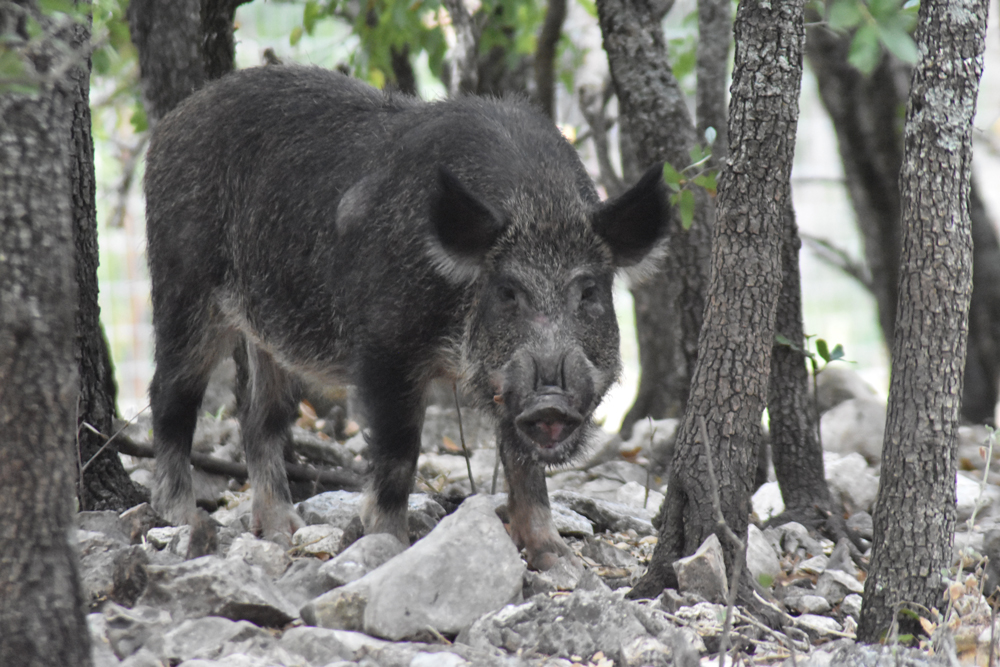Not much effect on the feral hog population yet, but it’s still early days.
Nine months after the Texas Department of Agriculture approved a new toxicant to curb crop-destroying feral hogs, many farmers and ranchers are still leery or unaware of the hog poison.
Scimetrics Ltd., the company that makes the bait — known by its brand name Kaput — said 586 people have been certified for its use so far in the state, only some of whom have begun its lengthy protocol.
Kaput’s hog bait contains warfarin, a blood thinner used as medication for humans that is toxic for hogs in low doses. It requires a state pesticide applicator license for use.
“The time we launched was probably not the best time,” said Mark Jones, who leads sales of the product. “We did it in April, so a lot of the crops were in or going in. Right now its (use is) picking up.”
[…]
Much of the early pushback came from hunters concerned the blood thinning medication in the hogs would be dangerous for humans and other animals, or worried the new solution would take out too much of their stock.
The last time Scimetrics held an open Kaput training session in 2017 in Waco, it drew a crowd of 200 ranchers, farmers and hog hunters, according to Jones.
“We had to close the meeting down because things got ugly,” he said.
A Texas-based feral swine processor even sued the Texas Department of Agriculture, which included supportive legal briefs from the Texas Hog Hunters Association and the Environmental Defense Fund. The case was later dropped.
After the state’s first attempt to get Kaput on shelves, the Texas legislature commissioned a study by the Texas A&M AgriLife Extension Service to test its safety and effectiveness.
The research team’s final report, released last August, cited findings to allay earlier concerns – including evidence first found in 2018 that a blue dye in the warfarin-laced bait showed up in the bodies of poisoned hogs within hours of its ingestion. It also found that the product worked.
“If the landowners are diligent and follow the labeling and manufacturer recommendations for the use of the product, it will kill pigs,” said Bruce Leland, the assistant state director of Texas Wildlife Services.
Still, the poisoning process is lengthy – hogs have to be trained on a feeder before farmers add live bait to the mix, and even then, they do not die immediately. Many of the researchers’ trials took several months from start to finish.
Tyler Rich, manager of West Texas’ Pro Chem Sales – one of 22 distributors of the feral hog bait in the state – said some of his customers find it well worth the trouble.
“We have one customer who buys a fair amount of the bait right now. He had one field where he had shot like 1,200 hogs in one year. They just decimate crops,” Rich said. “And they can’t shoot enough of them.”
Rich thinks Kaput does a good job of killing hogs without hurting other wildlife when its certified users follow the directions.
While baiting with Kaput is a long and expensive process — operators need to count on a hog-specific feeder and a long period of training the pigs — “it’s cheaper than losing all of your crops to the hogs,” Rich said.
See here and here for the previous updates. I don’t think anything is going to make a big difference in the feral hog population, but this may have some success over time. And maybe something more effective will come along later as a result. In the meantime there are still the traditional methods of hog control.


“Much of the early pushback came from hunters … worried the new solution would take out too much of their stock.”
These are invasive pests, not fingerling trout. If “too many” of them are killed (which seems extremely unlikely from the description) that’s a good thing.